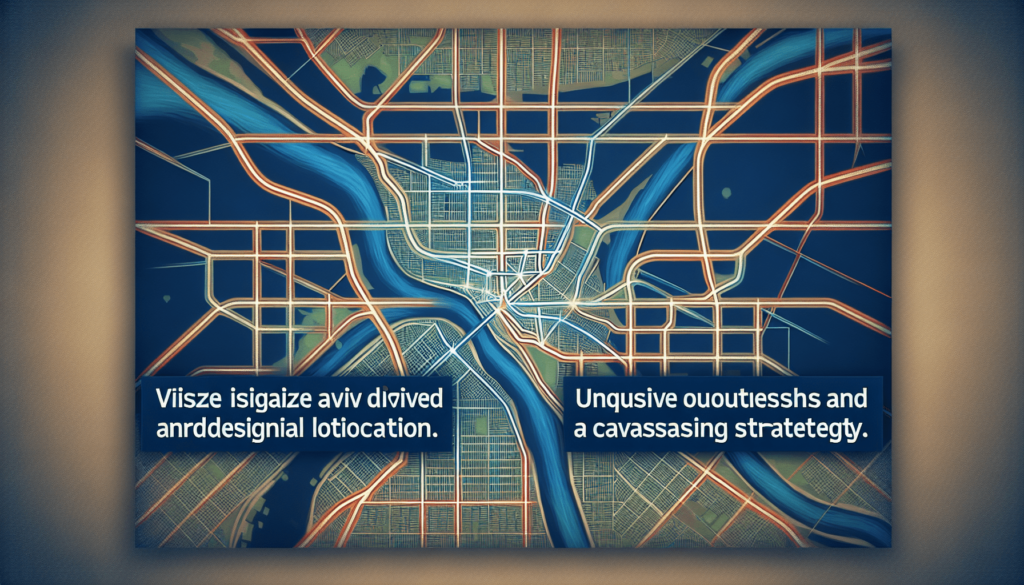Imagine you have a goal, a message that you want to spread far and wide. How do you get people’s attention and leave a lasting impact? That’s where a canvassing strategy comes in. In this article, we will explore the ins and outs of this powerful strategy and delve into how it works. Whether you’re a business owner looking to connect with potential customers or a political campaign aiming to engage voters, understanding the intricacies of a canvassing strategy can be the key to achieving your desired outcomes. So, let’s dive in and discover the magic behind this captivating approach.
Definition of a Canvassing Strategy
Explanation of a canvassing strategy
A canvassing strategy refers to a planned and systematic approach used to engage with individuals or groups in order to gather support, share information, or influence their opinions. It involves reaching out to people directly, either through face-to-face interactions, phone calls, events, or even online platforms. The goal of a canvassing strategy is to build relationships, enhance outreach and visibility, and ultimately achieve specific objectives, such as increasing awareness, driving action, or influencing behaviors.
Examples of a canvassing strategy
Canvassing strategies can be utilized in various contexts and for a range of purposes. For example, political campaigns often employ canvassing to mobilize voters, identify supporters or opponents, and sway public opinion. Nonprofit organizations may use a canvassing strategy to raise funds, increase awareness about their cause, or recruit volunteers. Community organizers can also adopt canvassing techniques to engage with residents, gather feedback, and promote community initiatives. These are just a few examples of how different entities can employ canvassing strategies to achieve their goals.
Benefits of Using a Canvassing Strategy
Increased outreach and visibility
Implementing a canvassing strategy can significantly enhance outreach efforts. By directly engaging with individuals, organizations can establish a personal connection and effectively communicate their message. Through face-to-face interactions or active dialogue over the phone, a canvassing strategy helps to build awareness and visibility for the cause or initiative, reaching individuals who may otherwise not have been reached through traditional marketing methods.
Targeted approach
One of the key benefits of a canvassing strategy is its ability to target specific audiences or demographics. By identifying the target audience beforehand, organizations can tailor their messaging and approach to resonate with those individuals. This targeted approach ensures that resources and efforts are focused on engaging with the right people, maximizing the impact and effectiveness of the canvassing strategy.
Direct communication
Unlike other forms of marketing or communication, a canvassing strategy allows for direct and personal communication. Whether it’s knocking on doors, making phone calls, or engaging with people at events, the ability to have a face-to-face conversation or engage in an interactive dialogue enables a deeper level of engagement. This direct communication creates an opportunity for organizations to build trust, establish credibility, and convey their message more effectively.
Building relationships
Canvassing strategies are not just about conveying information or influencing opinions; they are also about building relationships. By engaging with individuals directly, organizations can foster connections, understand their needs or concerns, and establish a sense of community. Building relationships through canvassing is crucial for long-term success, as it lays the foundation for ongoing support, collaboration, and advocacy.
Identifying support and opposition
A canvassing strategy allows organizations to gauge public opinion and identify levels of support or opposition. Through conversations and interactions, canvassers can gather valuable insights, understand the concerns and motivations of individuals, and identify potential advocates or adversaries. This information is invaluable for shaping future strategies, refining messaging, and gaining a deeper understanding of the target audience.
Real-time feedback
One of the distinct advantages of a canvassing strategy is the ability to receive real-time feedback. Through direct conversations or interactions, organizations can gather immediate reactions, opinions, and suggestions from individuals. This feedback can be used to refine strategies, adjust messaging or tactics, and address any concerns or misconceptions. Real-time feedback allows organizations to be responsive and adaptable, ensuring that their approach remains effective and aligned with the needs of their target audience.

Components of a Canvassing Strategy
Goal setting
The first step in developing a canvassing strategy is to clearly define the goals and objectives. Whether it’s raising awareness, mobilizing support, or driving action, having specific, measurable, attainable, relevant, and time-bound (SMART) goals is essential for guiding the strategy and evaluating its effectiveness.
Identifying target audience
Once the goals are established, the next step is to identify the target audience. This involves analyzing demographics, interests, and behaviors to determine who is most likely to support the cause or initiative. By understanding the target audience, organizations can tailor their messaging and approach to effectively engage with them.
Creating messaging and materials
Developing persuasive messaging is a critical component of a canvassing strategy. The messaging should be clear, concise, and compelling, conveying the key points and benefits of supporting the cause or taking the desired action. In addition to messaging, organizations should create engaging and visually appealing materials, such as flyers, brochures, or digital content, to support their canvassing efforts.
Recruiting and training volunteers
Volunteers are the backbone of any successful canvassing strategy. Organizations need to recruit enthusiastic and committed individuals who are passionate about the cause or initiative. Once volunteers are onboard, comprehensive training should be provided to equip them with the necessary knowledge, skills, and techniques to effectively engage with the target audience and represent the organization.
Mapping out canvassing routes
Efficiently mapping out the canvassing routes is essential to maximize productivity and coverage. Organizations should identify target areas or neighborhoods, divide them into manageable sections, and allocate volunteers accordingly. By optimizing the routes, organizations can ensure that resources are utilized effectively and that all targeted areas are adequately covered.
Implementing time management strategies
Time management is crucial for the success of a canvassing strategy. Organizations should establish a schedule that maximizes the availability of volunteers and aligns with the preferences and availability of the target audience. Efficiently managing time allows for more interactions, increases the chances of engagement, and ensures that the canvassing efforts are carried out in a timely manner.
Collecting and analyzing data
Data collection is an integral part of a canvassing strategy. Organizations should gather information during interactions, such as names, contact details, opinions, and preferences. This data can then be used for future outreach, follow-ups, and for evaluating the impact of the canvassing strategy. Analyzing the data helps organizations identify trends, measure outcomes, and make informed decisions for future strategies.
Evaluating and adjusting strategy
Continuous evaluation and adjustment is essential for the long-term success of a canvassing strategy. Regularly assessing the outcomes and effectiveness of the strategy allows organizations to identify areas of improvement, make necessary adjustments, and refine the approach. This iterative process ensures that the canvassing strategy remains relevant, effective, and aligned with the goals and objectives.
Steps to Develop an Effective Canvassing Strategy
Research and planning
The first step in developing an effective canvassing strategy is conducting thorough research and planning. This involves understanding the target audience, analyzing the competitive landscape, and identifying any existing challenges or barriers. By conducting research and careful planning, organizations can effectively tailor their strategy to address specific needs and circumstances.
Setting specific goals
Clear and specific goals are essential for guiding the development of a canvassing strategy. Organizations should define what they aim to achieve through their canvassing efforts, whether it’s increasing awareness, driving action, or influencing behaviors. These goals should be measurable, attainable, and time-bound, providing a benchmark for evaluating success.
Identifying target areas
Identifying target areas or neighborhoods is crucial for optimizing the effectiveness of a canvassing strategy. Organizations should conduct research to identify areas with a high concentration of individuals who align with their target audience. Target areas should be selected based on demographics, interests, and behaviors to ensure a higher likelihood of engagement and support.
Developing persuasive messaging
Creating persuasive messaging is a critical step in developing an effective canvassing strategy. Organizations should craft messages that effectively convey the value, benefits, and impact of supporting the cause or taking the desired action. The messaging should be clear, concise, and tailored to resonate with the target audience, ultimately motivating them to take the desired action.
Creating engaging materials
In addition to messaging, organizations should create visually appealing and engaging materials to support their canvassing efforts. This can include flyers, brochures, or digital content that reinforce the messaging and provide additional information or incentives. Engaging materials help capture attention, enhance credibility, and leave a lasting impression on the target audience.
Training and empowering volunteers
Volunteers play a crucial role in the success of a canvassing strategy. Organizations should invest time in training volunteers to effectively engage with the target audience, represent the organization, and address any questions or concerns. Empowering volunteers by equipping them with the necessary knowledge, skills, and confidence ensures that they can carry out their canvassing efforts effectively.
Implementing the strategy
Once all the necessary components are in place, organizations can begin implementing their canvassing strategy. This involves allocating volunteers to specific areas, providing them with materials and resources, and establishing a schedule that maximizes the availability of both the volunteers and the target audience. Implementing the strategy should be done with careful planning and coordination to ensure a smooth and effective execution.
Monitoring and evaluating results
Throughout the implementation of the strategy, organizations should continuously monitor and evaluate the results. This includes tracking engagement levels, collecting data, and measuring the outcomes against the defined goals. By monitoring the results, organizations can assess the effectiveness of the strategy and identify areas for improvement or adjustment.
Making necessary adjustments
Based on the evaluation of results, organizations should make necessary adjustments to their canvassing strategy. This could involve refining messaging, reallocating resources, targeting different areas, or adopting new approaches based on the feedback and insights gathered from the target audience. Making continuous adjustments ensures that the strategy remains dynamic, responsive, and aligned with the goals and objectives.

Types of Canvassing Techniques
Door-to-door canvassing
Door-to-door canvassing involves volunteers visiting individuals’ homes to engage in conversations, deliver messages, and gather support or feedback. It allows for direct, personal interactions and is particularly effective in building relationships and establishing trust.
Phone canvassing
Phone canvassing involves volunteers making phone calls to individuals to relay important messages, answer questions, or gather information. It is a cost-effective and efficient way to reach a large number of people quickly, and can be particularly useful when face-to-face interactions are not feasible.
Event-based canvassing
Event-based canvassing involves engaging with individuals at specific events or gatherings. This could include setting up booths, engaging in conversations, or distributing materials. Event-based canvassing allows for targeted engagement with a specific group of people who share common interests or concerns.
Street canvassing
Street canvassing involves engaging with individuals in public spaces, such as parks, shopping districts, or transportation hubs. It allows organizations to reach a diverse range of individuals and engage in spontaneous conversations, raising awareness and gathering support on the spot.
Online canvassing
With the advent of technology and online platforms, organizations can now engage in online canvassing through social media, email campaigns, or online surveys. Online canvassing allows for wider reach, immediate engagement, and the opportunity to gather feedback or support remotely.
Best Practices for Canvassing
Be prepared and knowledgeable
Canvassers should be well-prepared and knowledgeable about the cause or initiative they are representing. They should have a clear understanding of the messaging, goals, and key talking points to effectively convey information and answer questions.
Develop an empathetic approach
Approaching individuals with empathy and understanding is key to building relationships and establishing trust. Canvassers should listen actively, show genuine concern, and acknowledge the perspectives and experiences of the individuals they engage with.
Listen actively
Active listening is an important skill for effective canvassing. Canvassers should actively listen to the concerns, feedback, or questions raised by individuals they engage with, and respond in a thoughtful and respectful manner. This helps to build rapport and ensure that the messaging addresses the specific needs or concerns of the target audience.
Maintain a positive attitude
A positive attitude can go a long way in engaging with individuals and leaving a lasting positive impression. Canvassers should be enthusiastic, approachable, and maintain a positive demeanor even in the face of rejection or negativity.
Establish trust and rapport
Building trust and rapport is crucial for successful canvassing. Canvassers should strive to establish a personal connection, be authentic and transparent, and follow through on any commitments made during the engagement. This helps to build credibility and encourages individuals to support the cause or initiative.
Respect privacy and boundaries
Respecting privacy and boundaries is essential during canvassing. Canvassers should be mindful of personal space, avoid intrusive questioning, and respect any requests for privacy or non-engagement. Respecting boundaries demonstrates professionalism and ensures a positive experience for both the canvasser and the individual being engaged.
Document and track feedback
Canvassers should document and track feedback received during interactions. This can include capturing contact information, recording opinions or concerns, and noting any specific requests or commitments made. Keeping track of feedback helps organizations to follow up, address concerns, and improve their overall strategy.
Continuously improve
Canvassing is an iterative process that requires continuous improvement. Organizations should encourage feedback from volunteers and continuously evaluate the effectiveness of the strategy. This feedback can be used to identify areas for improvement, adjust messaging or tactics, and enhance the overall canvassing strategy.

Challenges and Solutions in Canvassing
Rejection and negativity
One of the challenges in canvassing is facing rejection or encountering negative attitudes from individuals. To overcome this, organizations should train volunteers in handling rejection, maintaining a positive attitude, and not taking individual responses personally. Emphasizing the importance of persistence and resilience can help volunteers navigate these challenges and continue their efforts.
Time management
Managing time efficiently is crucial in canvassing, as it involves coordinating volunteers, mapping out routes, and engaging with as many people as possible within a limited timeframe. Implementing time management strategies, such as prioritizing high-density areas or establishing specific time slots for canvassing, can help optimize time and resources.
Volunteer recruitment and retention
Recruiting and retaining volunteers can be a challenge in canvassing. To address this, organizations should create a compelling volunteer experience by providing training, recognizing and appreciating volunteers’ efforts, and fostering a sense of purpose and impact. Effective volunteer recruitment strategies, such as leveraging social networks, community partnerships, or online platforms, can also help attract dedicated volunteers.
Inaccurate or incomplete data
Data collection during canvassing can be susceptible to inaccuracies or incompleteness. To mitigate this challenge, organizations should provide clear guidelines and training to volunteers on data collection methods and ensure that they understand the importance of accurate and complete data. Regular data quality checks and follow-ups can help validate and verify the collected data.
Adapting to changing technology
As technology continues to evolve, organizations must adapt their canvassing strategies to leverage new tools and platforms. Staying up-to-date with technological advancements, such as utilizing mobile apps for data collection or incorporating social media outreach, allows organizations to expand their reach, engage with a wider audience, and improve the effectiveness of their canvassing efforts.
Examples of Successful Canvassing Strategies
Political campaign canvassing
Political campaigns often rely heavily on canvassing strategies to mobilize voters, identify supporters, and spread their message. Successful political campaign canvassing involves carefully targeting key demographics, delivering persuasive messaging, and building personal connections with voters. It can significantly impact voter turnout, campaign contributions, and ultimately, the election outcome.
Nonprofit outreach and fundraising canvassing
Nonprofit organizations often utilize canvassing strategies to raise funds, increase awareness about their cause, and recruit volunteers. Effective nonprofit canvassing involves identifying potential donors, telling compelling stories that resonate with their values, and building relationships with supporters. Successful fundraising canvassing can result in increased donations, long-term donor relationships, and financial sustainability for the organization.
Community organizing canvassing
Community organizing often relies on canvassing strategies to engage residents, gather support for community initiatives, and drive grassroots movements. Successful community organizing canvassing involves understanding the unique needs and concerns of the community, empowering residents to take action, and building coalitions to drive change. This type of canvassing can lead to community engagement, increased support for local initiatives, and positive social or environmental impact.

Impact and Effectiveness of Canvassing
Increased voter turnout
Canvassing has been shown to significantly impact voter turnout. Direct personal contact through canvassing, especially door-to-door canvassing, has proven to be one of the most effective strategies in mobilizing voters and encouraging them to cast their ballots. By engaging with individuals directly, canvassing can effectively convey the importance of voting, provide relevant information, and address any barriers or concerns, resulting in increased voter participation.
Successful fundraising and donations
Canvassing is an effective strategy for nonprofit organizations to raise funds and generate donations. By engaging directly with potential donors, canvassing allows organizations to share stories, convey the impact of their work, and build personal connections. This personal approach can significantly influence individuals’ decision to contribute, resulting in increased fundraising success and long-term support for the organization.
Community engagement and support
Canvassing plays a crucial role in fostering community engagement and support. By engaging directly with residents, canvassing allows organizations to understand the needs, concerns, and aspirations of the community. This engagement can lead to increased participation in community initiatives, volunteerism, and active involvement in shaping the community’s future.
Policy and legislative changes
Canvassing has the potential to influence policy and legislative changes. By engaging with individuals and communities, canvassing allows organizations to educate, advocate, and gather support for specific issues or causes. When done effectively, canvassing can raise awareness, mobilize public opinion, and drive change at the local, state, or even national level.
Conclusion
In conclusion, a canvassing strategy is a powerful tool for engaging with individuals, gathering support, and influencing opinions or behaviors. By employing a comprehensive canvassing strategy, organizations can enhance their outreach efforts, build relationships, and achieve specific goals. Whether it’s increasing awareness, mobilizing support, or driving action, a well-executed canvassing strategy has the potential to make a significant impact. From door-to-door canvassing to online outreach, there are various techniques and best practices organizations can adopt to ensure the effectiveness and success of their canvassing efforts. So, harness the power of canvassing and start making a difference today!





